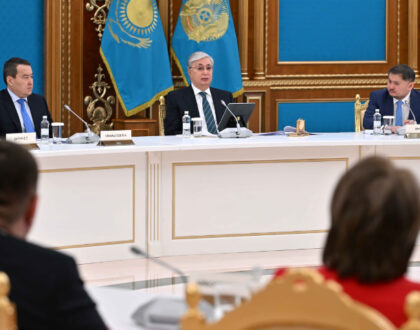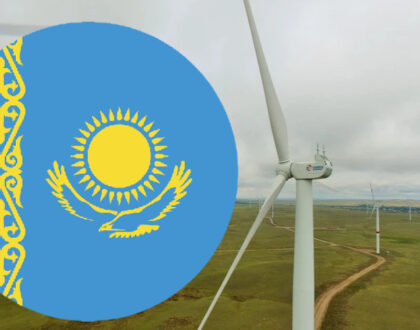Kazakhstan is Russia’s climate twin

How the climate is changing in Kazakhstan
- The average annual temperature increase in the country is 0.34 °C per decade (in Russia – 0.49 °C).
- In the west and south of Kazakhstan, there are more hot days with air temperatures above 35 °C. Their number increases by four to eight days every 10 years.
- Desertification, an increase in the number of fires in forests and steppes, the melting of glaciers, and the depletion of large rivers, reservoirs and agricultural lands await the country.
- In the mountains of eastern and southeastern Kazakhstan, an increase in the frequency of landslides, mudflows, avalanches, floods, hurricane winds, hail, frosts and droughts is predicted.
What climate goals are set by our Asian neighbour
Kazakhstan ranks 61st in the 2023 Predictive Climate Action Index (CCPI). In 2022, he was on the 64th line. The rating is compiled by the German non-profit organization Germanwatch. The country received such a low place due to high energy consumption, modest achievements in reducing greenhouse gas emissions, the introduction of low-carbon technologies and renewable energy sources, and the underdevelopment of climate policy. For comparison: Russia in the 2023 index dropped from 56th to 59th place. The top line of the ranking is occupied by Denmark, the last by Iran (63rd place, the new list is one line shorter than last year).

The authorities of Kazakhstan are shifting climate responsibility to future generations, according to a statement by the country’s environmental organizations (available from Plus-one.ru) . Experts believe that it is quite realistic for the state to reduce emissions by 50% by 2030, by 60% by 2040 and completely get rid of them by 2050. This is possible due to the development of renewable energy, energy saving, as well as reducing the use of coal, which accounts for half of all CO 2 emissions and at the same time less than 0.5% of employment. Nevertheless, Kazakhstan is going to achieve carbon neutrality only by 2060, like the Russian Federation.
Recall that Russia’s obligation under the Paris Agreement is not to exceed 70% of emissions from the 1990 level. Experts pointed out that the country, in fact, had already fulfilled it due to the fall of the economy in the 1990s.

Why Kazakhstan and Russia have so few climate ambitions
Kazakhstan and Russia are among the top twenty countries with the largest oil and gas reserves. This leaves an imprint on their climate policy. The basis of Kazakhstan’s exports is oil products (66%), Georgy Safonov, an international expert on climate and economics , explained to Plus-one.ru . This is followed by metals and their alloys, which are produced at enterprises that receive energy from coal plants. 90% of the equipment at the thermal power plant is Soviet, requiring a complete replacement, the economist notes.
According to Georgy Safonov, in order to strengthen climate ambitions, Kazakhstan needs to understand what it can trade besides raw materials, and how to rebuild its energy sector. “I think the first question is more important. The government and business are afraid to abandon oil as the main source of income,” the expert believes.
Kazakh enterprises have little to no external incentives to switch to green technologies, adds Evgeniy Tananaiko, deputy general director of Kept (formerly KPMG) in Russia. For example, there are no strict requirements for ferroalloys exported by the country. The cross-border carbon regulation that the EU will introduce for its suppliers in 2026 practically does not apply to exports from Kazakhstan: oil is not subject to it, and from metals Kazakhstan supplies insignificant volumes of steel and aluminum. The high dependence of energy on coal prevents the country from making a quick energy transition, Yevgeny Tananaiko believes. According to him, Kazakhstan does not have its own “green” products that could compete in the EU market, such as Rusal’s “green” aluminum produced on hydroelectric power.

How the country plans to reduce emissions
One of the main state mechanisms for reducing industrial emissions is the national emissions trading system (ETS). It has been operating in Kazakhstan since 2013; there is no such system in Russia. An experiment similar to a quota system was launched in September 2022 on Sakhalin.
In 2014, emission allowances were sold for the first time on a carbon exchange, by the way, the first in the CIS countries. Today, the state distributes 100% of quotas free of charge among enterprises that emit more than 20 thousand tons of CO 2 per year. The system covers oil and gas, energy, mining, metallurgical and chemical companies, as well as manufacturing companies that produce cement, lime, gypsum and bricks. The limit covers current emissions – ETS in Kazakhstan will only lead to a reduction in emissions if the government cuts quotas.
Quotas are distributed by Zhasyl Damu JSC, which is subordinate to the Ministry of Ecology of Kazakhstan. If an enterprise exceeds the norm, it can buy additional quotas from other market participants on the Caspian (CCX), Modern Trading Solutions and CTB exchanges, Zhasyl Damu auctions (not yet held) or directly. The volume of transactions in 2013-2015 amounted to at least $8.6 million, in 2018-2020 – $5.6 million. From 2018 to 2020, 52 such transactions were made in the country, from April to the end of July 2021 – six . The average cost of one ton of CO 2 is $3.38. For comparison: the first Russian carbon units on the Moscow Exchange were sold in 2022 at a price of $16.6 per piece.
An increase in the price of carbon quotas will help to find money for the modernization of the industry, as the Ministry of Ecology of Kazakhstan believes. According to forecasts of the department, by 2025 the price will rise to $17, and closer to 2030 it will reach $50. The energy sector, where 70% of the equipment is obsolete, such a rise in price can lead to bankruptcy. Expert of the Kazakhstan Association of Regional Ecological Initiatives ECOJER Alan Bokaev believes that the government is delaying the adoption of the country’s decarbonization plan for this reason: the risk of increasing electricity tariffs is too great.
Meanwhile, most climate projects in Kazakhstan, as well as in Russia, are associated with the transition to renewable energy, Evgeny Tananaiko notes.
At the beginning of 2022, 134 renewable energy facilities operated in the country with a total installed capacity of 2.01 thousand MW. Last year they produced 4220.3 million kWh. Over the past seven years, the installed capacity of renewable energy facilities has increased by almost 11 times.
The share of “green” energy in the country’s generation barely exceeded 3%. According to the draft decarbonization plan , by 2025 it should grow to 6%, by 2030 to 10%, and by the middle of the century, renewable sources should account for at least half of all energy consumption. For comparison: Russia plans to increase the share of renewable energy in the country’s energy balance by 10 times – from the current 1% to 10% by 2040. The Ministry of Energy of the Russian Federation expects that by 2035 about 6.7 GW of “green” capacities will be commissioned in the country.

According to the Ministry of Ecology of Kazakhstan, achieving carbon neutrality by 2060 will cost $650 billion. Of these, $305 billion will have to be invested in the production of electricity and heat, $167 billion in transport, $65 billion in mining and manufacturing, $57 billion in housing and communal services, $49 billion – in forestry.
The cost of Russia to achieve carbon neutrality by 2060, the experts of VTB Capital estimated at 479.8 trillion rubles. ($6.6 trillion at the exchange rate as of November 2021, when the estimate was given).
Most of the funding (about 96.5%) for decarbonization, the authorities of Kazakhstan are going to attract from the business. In March 2021, the taxonomy of green projects was adopted in the country. It outlines the types and technologies that banks, funds, investors, regulators and other market participants can use to shape their environmental programs and financial products such as green loans.
In 2020, with the support of the United Nations Development Program (UNDP), the first issue of “green” bonds took place at the site of the DAMU Entrepreneurship Development Fund. The funds raised were spent on the construction of a 2 MW solar power plant, which provides energy to the residents of the Shaulder village and the Temir railway station in the Turkestan region. The ESG finance market of Kazakhstan in July 2022 was estimated at $250 million.
In Russia, the first issue of “green” bonds in the amount of 1.1 billion rubles. ($17 million) was placed on the Moscow Exchange in December 2018. Investments were directed to the construction of a waste processing complex. The issuer was OOO Resursosberezhenie KhMAO (now — OOO Simatic-Yugra), which is engaged in the removal and disposal of waste. According to the Infragreen expert and analytical platform, from 2018 to 2021, green bonds dominated the Russian sustainable development bond market (79% of all environmental and social debt securities). For 23 issues, it was possible to attract 330.5 billion rubles. ($5.4 billion). The issuer of the largest issue of “green” bonds for 70 billion rubles. was the government of Moscow. The money is planned to be spent on the purchase of electric buses, as well as the construction of lines and stations of the Big Circle Metro Line. The second issue in terms of the amount of money raised belongs to VEB.RF – 50 billion rubles. The funds will go to projects in the areas of electric urban transport and housing and communal services.
When will Kazakhstan “get greener”
The locomotives of the Kazakh economy openly declare goals to reduce emissions. Thus, in 2022, the Eurasian Group (ERG, one of the eight largest enterprises in the field of oil production, energy and metallurgy) planned to reduce emissions by 2 million tons by 2030 through the use of renewable sources. National Company KazMunayGas JSC has adopted a low-carbon development strategy. The company’s goal is to reduce emissions by 15% by 2031 compared to 1990 levels.
The investment holding Samruk-Kazyna, which manages 583 state-owned assets worth about $69 billion, planned to develop a low-carbon development concept by the end of 2021, but has not yet presented it. The program should explain how the financial giant is going to cut its companies’ emissions by 10% by 2031.
“Companies are now developing plans to implement their climate strategies. I think we will be able to see progress on the horizon of two or three years, ” Ainur Teleigenova, Deputy Director of the Freedom Finance ESG Department, explained to Plus-one.ru.
A significant part of the equipment necessary for the modernization of the Kazakh industry, including Soviet thermal power plants, was produced in Russia, Evgeny Tananaiko said. “However, now, due to the implementation of the import substitution program, the country will work for the domestic market. The choice of another supplier will lead to a shift in the timing of modernization, ”the expert explained. In his opinion, a noticeable reduction in emissions in Kazakhstan should not be expected in the next five to seven years.



